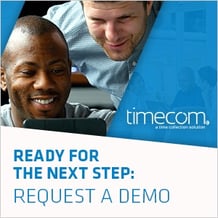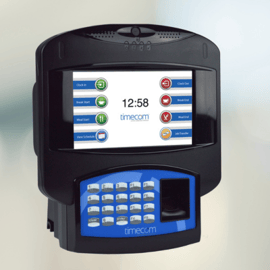Prioritizing positive employee experiences with your time clock can encourage quick acceptance of your Oracle Time and Attendance system amongst your employees, leading to a better return on investment. To fully integrate your Oracle HCM products with a time clock, it's crucial to choose a solution that provides the right mix of features and flexibility. In this article, we'll explore how the right time and attendance software can enhance your Oracle workforce management experience for employees, delivering an efficient and user-friendly solution.
 make attendance management easy for employees when they use the time clock
make attendance management easy for employees when they use the time clock
Selecting a time clock that supports multiple reader options is essential. This ensures that your employees can easily utilize the time clock so all their data can be sent to your Oracle Time and Attendance system.
time clock reader options
Here are popular reader options and some of the different benefits each option provides.
Biometric Readers
B iometric readers offer a secure and convenient way for employees to clock in. With no physical credentials to lose, employees can always clock in, improving the accuracy of their time and attendance data. By utilizing a biometric time clock, the employee can use the clock with their physical trait like a fingerprint.
iometric readers offer a secure and convenient way for employees to clock in. With no physical credentials to lose, employees can always clock in, improving the accuracy of their time and attendance data. By utilizing a biometric time clock, the employee can use the clock with their physical trait like a fingerprint.
Proximity (RFID) Cards
 Proximity (RFID) cards provide a fast and touchless experience. Employees will have to wave their card in range of the clock to have their attendance data recorded to your Oracle time and attendance system.
Proximity (RFID) cards provide a fast and touchless experience. Employees will have to wave their card in range of the clock to have their attendance data recorded to your Oracle time and attendance system.
Swipe Badges
Swipe badges offer a familiar and convenient option for employees. Swipe badges may be older technology, but they can still provide your employees with a high value experience. With the swipe functionality, your employees will have the accessibility of swiping their badge/card in the badge slot to seamlessly send their punch information to your Oracle time and attendance system.
If you want to learn more about the advantages of low-touch time clocks, check out:

offer oracle-integrated services at the time clock
When you deliver Oracle-integrated services at the time clock, you improve the Oracle Time and Attendance experience for your employees. Here, we explore three ways the Oracle HCM integrated services at the time clock enhance your company’s experience:
- Improved reporting for payroll and HR managers
- More accessibilities for hourly employees
- Improved employee communication
Impress hr and payroll managers with reporting
Human resources and payroll employees want more from your Oracle workforce management systems than payroll automation. Sharing data between your time clocks and the Oracle workforce management solution provides HR and payroll managers with powerful reporting tools for improved workforce management analytics. With accurate and up-to-date employee attendance data, these managers can identify patterns and trends to reduce labor costs and improve compliance with labor laws.
For example, reports can identify trends of over or under-staffing shifts or when a manager may be scheduling excessive overtime during a pay period. Here are some more ideas on how you can take advantage of robust data sharing between the time clock and Oracle system:
give your hourly employees more access
Hourly employees are your primary users of Oracle HCM at the time clock. Using the Oracle - time clock integration to give them more access to their information can lead to greater engagement and satisfaction.
Oracle - time clock integration to give them more access to their information can lead to greater engagement and satisfaction.
Employees can access important information such as:
- Past payroll details from two weeks back
- Available PTO
- Upcoming scheduling information with your chosen software integration
Advanced time clocks can also be configured so employees can complete tasks without having to go through human resources or management, including:
- Submitting time-off requests.
- Completing attestations, for example, confirming that the employee didn’t witness a workplace accident during their shift.
Having a high-definition touch screen on the time clock makes it easy for employees to view and interact with their information.
improve employee communications
Communicating regularly and clearly with employees is a surefire way to boost the quality of employee-management relations. These time clock features can create a more accessible communication center right at the time clock:
quality of employee-management relations. These time clock features can create a more accessible communication center right at the time clock:
- High-definition touch screen
- Speakers
- Web-connection
You can use these features to share customized messages with your employees as they punch in or out. For example, you can share:
- Changing friendly welcome messages to start their day
- Important company updates, such as important announcements and deadline dates
- Reminders to complete a task
You are contributing to a more engaged and informed workforce when you can use your time clocks to communicate directly with employees. Your workforce will appreciate being informed, which leads to a more open and connected work environment. Supporting a communicative employee culture can increase talent retention, avoiding the costs of high employee turnover.
simplify workforce management
You can also use your time clocks to optimize your workforce management. Innovative time clock software solutions let you limit which time clocks specific groups of employees can use. For example, software groupings can limit employees to time clocks close to where they work on-site. This helps ensure that employees are in the right place on time and reduces delays at time clocks in high-traffic areas.
If the business needs specific business rules that apply to certain departments or business units, the time clock software should be able to accommodate those, too. This could include requiring different meal break rules based on time clock location. Controlling these management workforce rules through the software gives you flexibility to adapt to different or changing needs across the business.
The more complex the workforce, the more you should expect from the time clock and Oracle HCM software integration. For example, companies that use contingent workers have special needs. If your company is growing quickly, having time clocks robust enough to handle the increased use and larger volume of collected data is critical to smooth functioning of your time and attendance system.

timecom: a validated-oracle hcm cloud time clock solution
Since the time clock is the primary point of interaction with your Oracle Time and Attendance system for most employees, it’s crucial that their time clock interaction is efficient and helpful. To ensure the success and optimization of your entire Oracle HCM cloud system, selecting the right time clock system is a worthwhile investment.
Our TimeCom product is a purpose-built cloud-based solution that works with Oracle HCM Cloud Time and Labor to provide your company with a state-of-the-art workforce management system. You can choose from various time clocks optimized for the Oracle Cloud Time and Labor solution.
The TimeCom system includes advanced data collection software that runs on the time clock and an additional layer of software that manages the bi-directional data flow between the time clocks and your Oracle system. It’s due to TimeCom’s advanced software capabilities and Oracle integrations that your teams will have access to additional time clock and workforce management software tools for:
- Improved reporting and monitoring, including real-time visibility into entire time clock deployment.
- Converting time clocks as employee self-service devices.
Want to see what TimeCom and its Oracle integration can do for your company? Schedule a live online demo with one of our experts today.




 make attendance management easy for employees when they use the time clock
make attendance management easy for employees when they use the time clock iometric readers offer a secure and convenient way for
iometric readers offer a secure and convenient way for Proximity (RFID) cards provide a fast and touchless experience.
Proximity (RFID) cards provide a fast and touchless experience.

 quality of
quality of
